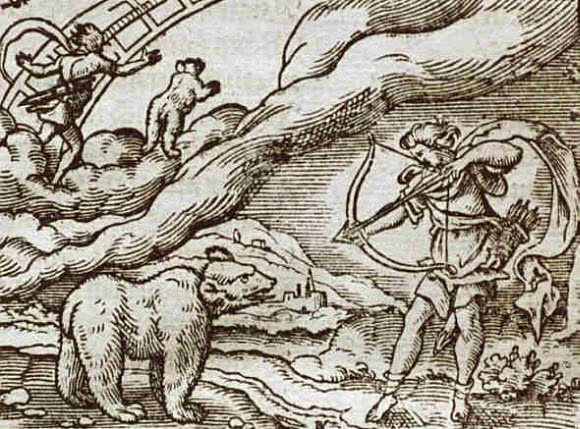I always view early autumn with a certain amount of nostalgia as it was around this time I first became interested in identifying the stellar patterns visible in the night sky. As it turns out early October is almost ideal to do so;- summer constellations remain well placed as soon as darkness falls, those associated with autumn take centre stage later in the evening and waiting in the wings is the brilliant stellar canopy of winter, a vista to savour. Of course I knew nothing of this as a young boy, but having just acquired a pair of second hand binoculars, a couple of astronomical books, and inspired by the many wonderful tales and legends associated with the constellations, early October seemed particularly suitable.

Google Dream image of the Two Bears: Ursae Major & Minor, overlayed for emphasis.
I took my first celestial steps with one of best-known star patterns, the Plough, the outline of which resembles a ‘dot to dot’ saucepan (also known as the Big Dipper). The Plough is really an asterism, a distinctive pattern within a constellation – in this case Ursa Major, the Great Bear. Throughout autumn evenings the Plough resides at an observer friendly altitude in the NNW as it endlessly circles celestial pole.
In Greek mythology Ursa Major represents Callisto, daughter of King Lycaon of Arcadia who after a liaison with Zeus bore a child, Arcas. In order to save Callisto from his enraged wife Hera, Zeus turned Callisto into a bear. Many years later whilst out hunting, Arcas was about to kill a large bear when Zeus hurriedly intervened; knowing the bear to be Callisto, and turned Arcas into a bear also. Reunited, mother and son were then swung into the heavens out of harm’s way by their tails. Ursa Minor represents Arcas.

The story of Calisto and Arcas
Five of the stars forming the Plough asterism are genuinely associated, sharing the same speed and trajectory through space. These, along with a number of other stars in the northern part of the sky, as well as Sirius, brightest star in the night sky, are all members of the Ursa Major moving star cluster. If you have decent eyesight you should be able to detect that the middle star in the handle is double. Binoculars show Mizar and Alcor well, but a telescope also reveals that Mizar itself is a striking double star.
There are numerous deep sky objects dotted around Ursa Major, most of which require a scope to spot, but the twin galaxies of M81 and 82 are somewhat brighter, even visible as smudges in binoculars.
Ursa Minor is rather a faint constellation and is home to Polaris - the present pole star. Use the ‘pointer’ stars; to track it down.
Return to the Plough and follow round the curve of the handle to locate Arcturus, the brilliant star low in the WNW highlighting the outline of Bootes the Herdsman. To the upper left of Arcturus look for the delicate starry circlet of Corona Borealis - the Northern Crown. Its leading star, Gemma (latin for jewel) is set in the midst of this pleasing arrangement. According to Greek legend Corona represents the crown of Dionysus, tossed into the heavens to prove his love for Ariadna after she had recently been deserted by Theseus (from the Minataur legend) vowing never to marry a mortal again. Dionysus was a god of course.
The Herdman’s dogs - Canes Venatici - are situated beneath the Ploughs handle and marked by two stars. The brighter one, Cor Caroli, meaning Charles’s heart, was named in honour of King Charles II.
My favourite tale for this part of the sky however stems from the Iroquois Indians and ties in Corona, Arcturus and the stars of the Plough or Big Dipper. Represented by the stars of the Plough the bear is hunted by seven warriors when each spring the animal leaves its den; Corona Borealis. The bear is not killed until autumn whereupon its spirit is released; represented by setting Arcturus, whose name means ‘Bear Keeper’. The skeleton of the bear, the seven stars remains in the sky until the following spring when a new bear emerges from Corona, complete with renewed spirit and the hunt begins again.
Through the eyes of a small child such stories woven by our ancestors on the grandest of scales not only brought the starry heavens to life, but actively encouraged in setting out on a voyage of celestial discovery. Hopefully they still have the capacity to enhance your appreciation of the night sky.
- Log in to post comments
